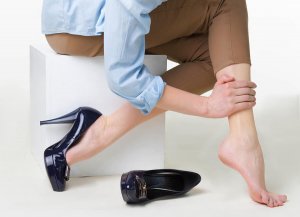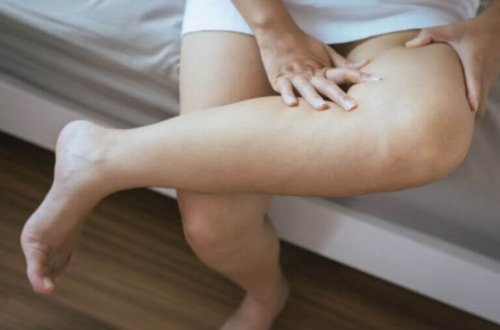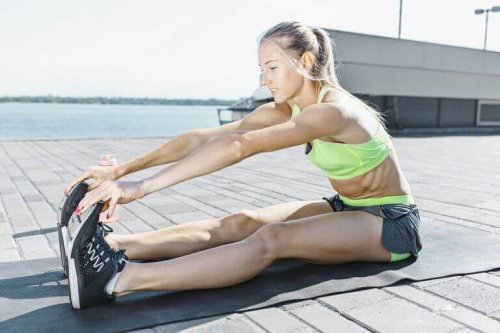Poor Leg Circulation: Prevention and Treatment

Poor leg circulation can be a symptom of health problems such as venous insufficiency. In this article, we’ll discuss treatment and prevention.
Although one of the principal reasons for poor leg circulation is a sedentary lifestyle; it’s also a result of aging. This can occur in people due to a genetic predisposition or a circulatory problem.
In this article, we’ll take an in-depth look at poor circulation in the legs and what it consists of. In addition, we’ll give some preventative steps and some possible treatment options.
Poor leg circulation: causes and physiology
There are many causes that can slow down the circulation of blood in our body. However, this occurs more in the legs due to the force of gravity. Generally, when we talk about poor circulation we mean blood that runs through the veins versus the arteries. Therefore, this comes from the tissues to arrive at the heart to receive oxygen again.
Arterial circulation is a high-pressure function, but venous circulation tends to occur at a much slower rate. In order to compensate for this, the veins tend to have some valves that avoid blood reflux.
The reasons for poor circulation are numerous. Nevertheless, there’s always a morphological change that points to an inefficient venous system. Because of this, in many cases, this morphological change is related to arteriosclerosis.
Arteriosclerosis
Arteriosclerosis is a chronic condition that occurs with aging. To explain, it consists of the formation of plaque in the arteries. The composition of the plaque is cholesterol on the walls of the arteries.
Usually, this occurs in the medium-sized veins when the hardening of arteries occurs. This can cause a malfunctioning of the venous valves.

Besides, plaque in the arteries can cause small blood clots and can also migrate to the venous system. Then they adhere to the venous walls and form a thrombus. This is the origin of conditions such as phlebitis.
Phlebitis is an illness that can occur in a major or minor way with age. Furthermore, smoking is one of the principal causes of this. It irritates the endothelium, the delicate lining of the arteries. Also, it predisposes it to form arterial plaque.
A person who is 50 years old and smokes could have the arteries of someone who is 70. Therefore, to reduce the appearance of undesirable symptoms, it’s vital to stop smoking.
Diabetes
Diabetes is another illness associated with poor circulation. Even worse, in advanced cases, there can be serious problems. It can end up with microcirculation problems due to toxicity with excess glucose in the capillaries.
Varicose veins and poor leg circulation
Varicose veins are the main manifestation of insufficient blood flow in the veins. Because of this, there’s poor circulation in the legs. This tends to appear in young people who have a predisposition to it. However, in this case, it’s less important.
Nevertheless, this can be an alarming symptom in older people and can cause cardiovascular pain. Since this can be serious, it’s best to treat the root cause. Also, as it turns out, one of the main causes of varicose veins is insufficient blood flow.
Prevention and treatment
In this section, we’re going to give steps and advice to prevent or treat symptoms of poor circulation in the legs. It pertains to spider veins, varicose veins, or tingling in the legs. Many cases may be overlapping since the objective is to improve circulation. So these can be for current symptoms as much as prevention.
- Do physical exercise: sport is good for cardiac health and increases the speed at which blood moves through the blood vessels.
- Follow a healthy and balanced diet: it’s especially important to eat heart-healthy foods. For instance, omega-3, contained in fish or in dried fruits. Also, experts recommend reducing the consumption of salt.
- Drink plenty of water: this stimulates kidney filtration and avoids fluid retention

How to alleviate symptoms of poor circulation
We’ve identified symptoms such as spider veins, varicose veins, tingling, or retention of fluids. So now we can take measures to reduce these symptoms. However, we need to take into account what the underlying illness is so that we know how to treat it. If we fail to do this, symptoms will return.
- Use compression socks to avoid the formation of clots. Exercise elevates the heart rate and increases the speed that the blood moves through the veins.
- Massages are a great tool to improve circulation. With palpitation, they’ll help to improve venous return.
- Raising the legs. This can also be helpful to improve venous return.
In certain situations, it may be necessary to treat poor leg circulation surgically or with medication. There are a few invasive surgeries that can remove varicose veins. The medication that doctors prescribe is an anticoagulant to avoid the formation of clots.
Poor leg circulation can be a symptom of health problems such as venous insufficiency. In this article, we’ll discuss treatment and prevention.
Although one of the principal reasons for poor leg circulation is a sedentary lifestyle; it’s also a result of aging. This can occur in people due to a genetic predisposition or a circulatory problem.
In this article, we’ll take an in-depth look at poor circulation in the legs and what it consists of. In addition, we’ll give some preventative steps and some possible treatment options.
Poor leg circulation: causes and physiology
There are many causes that can slow down the circulation of blood in our body. However, this occurs more in the legs due to the force of gravity. Generally, when we talk about poor circulation we mean blood that runs through the veins versus the arteries. Therefore, this comes from the tissues to arrive at the heart to receive oxygen again.
Arterial circulation is a high-pressure function, but venous circulation tends to occur at a much slower rate. In order to compensate for this, the veins tend to have some valves that avoid blood reflux.
The reasons for poor circulation are numerous. Nevertheless, there’s always a morphological change that points to an inefficient venous system. Because of this, in many cases, this morphological change is related to arteriosclerosis.
Arteriosclerosis
Arteriosclerosis is a chronic condition that occurs with aging. To explain, it consists of the formation of plaque in the arteries. The composition of the plaque is cholesterol on the walls of the arteries.
Usually, this occurs in the medium-sized veins when the hardening of arteries occurs. This can cause a malfunctioning of the venous valves.

Besides, plaque in the arteries can cause small blood clots and can also migrate to the venous system. Then they adhere to the venous walls and form a thrombus. This is the origin of conditions such as phlebitis.
Phlebitis is an illness that can occur in a major or minor way with age. Furthermore, smoking is one of the principal causes of this. It irritates the endothelium, the delicate lining of the arteries. Also, it predisposes it to form arterial plaque.
A person who is 50 years old and smokes could have the arteries of someone who is 70. Therefore, to reduce the appearance of undesirable symptoms, it’s vital to stop smoking.
Diabetes
Diabetes is another illness associated with poor circulation. Even worse, in advanced cases, there can be serious problems. It can end up with microcirculation problems due to toxicity with excess glucose in the capillaries.
Varicose veins and poor leg circulation
Varicose veins are the main manifestation of insufficient blood flow in the veins. Because of this, there’s poor circulation in the legs. This tends to appear in young people who have a predisposition to it. However, in this case, it’s less important.
Nevertheless, this can be an alarming symptom in older people and can cause cardiovascular pain. Since this can be serious, it’s best to treat the root cause. Also, as it turns out, one of the main causes of varicose veins is insufficient blood flow.
Prevention and treatment
In this section, we’re going to give steps and advice to prevent or treat symptoms of poor circulation in the legs. It pertains to spider veins, varicose veins, or tingling in the legs. Many cases may be overlapping since the objective is to improve circulation. So these can be for current symptoms as much as prevention.
- Do physical exercise: sport is good for cardiac health and increases the speed at which blood moves through the blood vessels.
- Follow a healthy and balanced diet: it’s especially important to eat heart-healthy foods. For instance, omega-3, contained in fish or in dried fruits. Also, experts recommend reducing the consumption of salt.
- Drink plenty of water: this stimulates kidney filtration and avoids fluid retention

How to alleviate symptoms of poor circulation
We’ve identified symptoms such as spider veins, varicose veins, tingling, or retention of fluids. So now we can take measures to reduce these symptoms. However, we need to take into account what the underlying illness is so that we know how to treat it. If we fail to do this, symptoms will return.
- Use compression socks to avoid the formation of clots. Exercise elevates the heart rate and increases the speed that the blood moves through the veins.
- Massages are a great tool to improve circulation. With palpitation, they’ll help to improve venous return.
- Raising the legs. This can also be helpful to improve venous return.
In certain situations, it may be necessary to treat poor leg circulation surgically or with medication. There are a few invasive surgeries that can remove varicose veins. The medication that doctors prescribe is an anticoagulant to avoid the formation of clots.
All cited sources were thoroughly reviewed by our team to ensure their quality, reliability, currency, and validity. The bibliography of this article was considered reliable and of academic or scientific accuracy.
- Aronow W. Peripheral arterial disease in the elderly. Clin Interv Aging [Internet]. 2008 Jan [cited 2019 Nov 14];Volume 2:645–54. Available from: https://www.dovepress.com/peripheral-arterial-disease-in-the-elderly-peer-reviewed-article-CIA
- Olive JL, DeVan AE, McCully KK. The effects of aging and activity on muscle blood flow. Dyn Med. 2002 Dec 19;1:1–7.
- Deitrick G, Charalel J, Bauman W, Tuckman J. Reduced arterial circulation to the legs in spinal cord injury as a cause of skin breakdown lesions. Angiology. 2007 Apr;58(2):175–84.
This text is provided for informational purposes only and does not replace consultation with a professional. If in doubt, consult your specialist.








